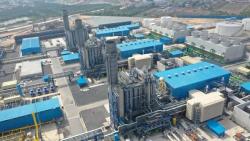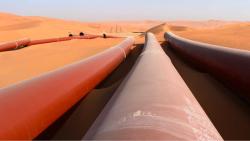
OR WAIT null SECS
© 2024 MJH Life Sciences™ and Turbomachinery Magazine. All rights reserved.
Turbomachinery for offshore LNG
Liquefaction of natural gas to LNG in floating module is the only available option for remote offshore gas reservoirs. Aero-derivative gas turbine driven centrifugal compressors -- because of compact, light-weight, simple and reliable design -- are the best and optimum selection for offshore LNG units. Presented concepts and details in this article allow substantial reduction in total cost of ownership, better production flexibility and reliability of offshore refrigeration centrifugal compressor trains.
The LM2500G4 gas turbine is a 34 MW aero-derivative two-shaft machine with efficiency above 42%. Two-stage power-turbine provides shaft normal speed around 6100 rpm (operating range 3600 rpm to 6400 rpm). Variable geometry air compressor inlet guide vane and variable stator vane technologies are used to improve starting as well as reasonable efficiencies in part load operation. LM2500 gas turbines are usually offered in single base-plate configuration including gas turbine, enclosure and auxiliaries, total dimension around 6.5x3.6x4 m and weight 40 t.
LM6000 is multi-spool machine that exhibits a large speed range. It is an around 42% efficiency gas turbine offered more than 44 MW simple-cycle power. Six stage turbine offers 3600 rpm speed (speed range capability at around 55-105% of nominal speed). It is usually offered in single base-plate configuration.
Trent 60 is a large and modern aero-derivative gas turbine available today for industrial use. It can deliver up to 64 MW power (42% efficiency). This machine offers great flexibility.
The LMS100 is a large aero-derivative three-shaft gas turbine. It can produce more than 100 MW with around 45% efficiency. The LMS100’s aero-derivative core and power turbine allows operating flexibility which is very rare in any other gas turbines of 100 MW size. It uses annular combustion chamber and advanced inter-cooling technology to increase power and efficiency. It has three turbine sections (HP, MP and LP). Power turbine can be optimized for different power turbine speeds (3,000rpm, 3,600rpm, etc). The modular design, part-load efficiency, operation characteristics and ability to change-out the main modules around 24-48 hours, provide increased flexibility, availability, reliability and easy maintenance.
LNG PROCESSES FOR OFFSHORE
Perhaps the process contributing the most tonnage of LNG worldwide is APCI LNG. This process includes two main refrigerant cycles: 1- A propane pre-cooled cycle. 2- Mixed refrigerant (MR) cycle. The pre-cooling stage of the incoming stream is in a separate propane chiller and can cool the process gas down to around -40°C. The MR in this process usually consists of nitrogen, methane, ethane and propane, used in the liquefaction and sub-cooling cycle. In the MR cycle, the partially liquefied refrigerant is separated into vapor and liquid streams that are used to liquefy and sub-cool the process stream to a typical temperature below -150°C. The overall vaporized MR stream from the bottom of the cryogenic heat exchanger is recovered and compressed by the MR compressor to around 48 Bara. It is cooled and partially liquefied first by water or air, then by the propane refrigerant, and recycled to the exchanger. The Shell Double Mixed Refrigerant process (DMR) is close to the APCI system. Rather than propane, the pre-cooling is accomplished by a refrigerant consisting mainly of ethane and propane. Another key difference is that the pre-cooling is carried out in heat exchangers rather than kettles. These two processes (APCI and DMR) are suitable processes for large offshore floating LNG units.
The PRICO LNG process is a single MR LNG process. The refrigerant usually consists of nitrogen, methane, ethane, propane, butane and pentane. A single driver compressor system compresses the refrigerant (using a single multi-casing compression train). The cooling and liquefaction is carried out at several pressure levels, in plate-fin heat exchangers located in cold boxes. The PRICO LNG process is favorite process for medium size offshore LNG units.
Small size LNG processes are capable of producing LNG in a single loop, served by a mixed refrigerant single shaft, multi-stage, single casing centrifugal compressor. It is close to PRICO LNG process. Rather than multi-casing train, it uses single casing compressor.
OFFSHORE REFRIGERATION COMPRESSOR
The various refrigerant compression systems can have separate drivers or integrated to have two compression strings. Best configuration for large offshore LNG module is two trains driven by two identical frame aero-derivative gas turbines. One common-in-use LNG refrigeration configuration (utilizes two compression trains) uses two identical gas turbine frames. This design offers simplicity, exchangeability, and better commercial conditions. An example is described considering propane (C3) - mixed refrigerants (MR) APCI LNG process. The propane compressor and the high-pressure MR compressor share one string, while a combined low-pressure and medium-pressure MR compressor resides on the other string. Centrifugal compressor with side streams is usually used for propane compression (pressure around 15 to 25 bar). There are different compressor arrangements available. In a typical compressor model, first impeller is semi-open type and six additional impellers are closed type. Side-stream is usually taken from an exchanger where it is flashed to a vapor, resulting in a stream temperature near saturation. As such, the side-stream would act to cool the total stream.
Extraction side-stream could be used where heated gas at less than discharge pressure is required. Using the extraction saves the energy needed to compress this quantity of gas to the full discharge pressure and then throttling. Side-stream inlets allow optimum use of the pre-cooled gas in the liquefaction process. Inlet and outlet seals are of the dry gas type, with carbon ring separation. Mixing of the high volumetric flows entering as side-streams and side-stream loading are of critical importance in the compressor design. Flow path design when the flow comes into the compressor from a side-stream nozzle, needs special attention. For LNG refrigeration compressor applications usually the pressure ratio can be defined fairly precisely and a 10 percent margin is sufficient for capacity. Pass-in side-stream pressures, within the compressor, are specified at value(s) below that anticipated in service to minimize the risk of the compressor generating high pressure backing out the side-stream flow. Pass-out side-stream pressures are subject to the same margin above anticipated pressures. In the absence of better data, consider 5% margin.
DESIGN AND MATERIAL SELECTION
There are highly-efficient vertically-split centrifugal compressors available for handling propane and mixed refrigerant (MR) services in offshore LNG units. The mixed refrigerant is usually compressed in two or three process stages. Back-to-back multi-stage arrangement is very common. In LNG applications, due to low operating temperatures, care must be taken that piping connected to compressors do not cause excessive loads which lead to distortion and misalignment of compressor. For minimum capital cost, the maximum permissible tip speed is selected. Maximum tip speed is governed by strength limitation, sonic considerations and Mach number. The critical Mach number occurs at the eye of the impeller, and is often kept below about 0.9 to avoid choking at the inlet. However for large propane compressors, higher values are usually used. In such case, careful optimization is always required considering aerodynamic, mechanical and commercial conditions. Permissible number of impellers is function of rotor-dynamic, Mach number, flow coefficient and tip speed. As a general indication for compressor with side stream, 5 or 6 impellers per casing is recommended (maximum 7 impellers per casing may be used). Maximum eight (8) impellers per casing recommended for design without side stream. However best advice is to check maximum number of impellers with compressor manufacturer.
LNG low temperature applications present challenges to compressor design and fabrication. All components should be evaluated for the prevention of brittle fracture (materials exhibiting change from ductile to brittle fracture as temperatures are reduced). Refrigeration compressors have complex dynamic behavior due to many reasons such as large sizes, high Mach number, high tip speed, etc. Given offshore LNG concerns, such as oil contamination, compact and light-weight design requirements and high expected reliability, magnetic levitation bearings is best selection. In magnetic bearings, sensors monitor the shaft’s position and supply that data to a controller. The controller can change the current in the coils and thereby correct shaft position. Magnetic bearing applications are increasing in all offshore services.
CASE STUDIES
The first case study reviews a typical 2 mtpa for a large offshore LNG module based on propane (C3)-mixed refrigerants (MR) APCI LNG process. Two compressor trains are used. Each compressor train power is around 40 MW (driver LM6000). Propane pre-cooling compressor is a five impeller centrifugal compressor with inlet flow around 105,000 m3/hr. For LP/MP stages of mixed refrigerant (MR) compression, six impellers centrifugal compressor is used. Three impellers serve in the role of low-pressure (LP) MR compression, with the MR stream then leaving the compressor and being inter-cooled externally before being reintroduced into the second three impellers of the compressor, which serve in the role of medium-pressure (MP) MR compression. Inlet flow of the LP/MP compressor is approximately 230,000 m3/hr. Seals of propane and MR compressors are tandem type dry gas with carbon ring separation. The final high-pressure (HP) stage of MR compression resides on the same string as the propane compressor, and is accomplished with a five impellers compressor. Flow of the HP MR compressor is approximately 33,000 m3/hr. The MR gas is about 42% methane, 43% ethane, 12% propane and the rest nitrogen with trace amounts of other gases.
The second case study is a MR refrigeration compressor for relatively small size 0.5 mtpa offshore LNG units (using single loop, single MR refrigeration cycle). Compressor is 8 impellers, around 29 MW vertically-split centrifugal compressor driven by aero-derivative gas turbine (LM2500).
(Amin Almasi is a rotating machine consultant based in Brisbane, Australia)


